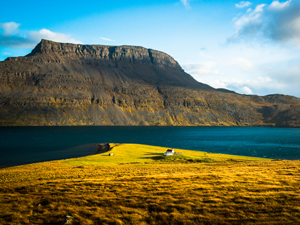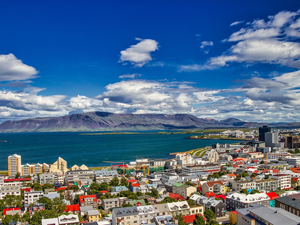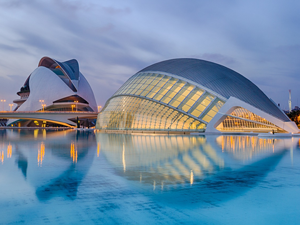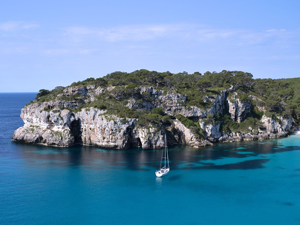On August 12, 2026, a total solar eclipse will trace a narrow path of totality across a remote region of Siberian Russia, eastern Greenland, the west coast of Iceland, northern Spain, and a tiny section of Portugal. To experience the total phase of the eclipse, or "totality," you must be located within this narrow path of totality, with the duration of totality lasting the longest at the centerline. But where along the path should you plan to go? Below, we've outlined some of the unique features, landmarks, and viewing options along the path of totality. Since the vast majority of the population along the eclipse path is located in Iceland and Spain, and this is where almost all travelers will plan their eclipse trips to, most of this overview will concentrate on those two countries in particular.
Remember that you must use special eclipse safety glasses or viewers at all times during the partial phases of a total solar eclipse. The NationalEclipse.com Eclipse Store offers a wide variety of certified safe eclipse glasses and viewers.
Note that times and durations can vary widely even within the same city and some cities are located only partially within the path of totality. All times and durations noted on this page are only representative samples and should be used for general comparison purposes only. To determine the precise start time, end time, and duration of totality for your exact location on eclipse day, use the interactive eclipse maps developed by Xavier Jubier.
Note that the eclipse path gradually changes its direction from south to east as it travels across the planet. To avoid confusion, note that references made below to the "western" or "southern" limits or lines of the eclipse refer to the left/bottom edge of the path and references made to the "eastern" or "northern" limits or lines of the eclipse refer to the right/top edge of the path.
While the paths of most total solar eclipses race across the planet in a roughly west-to-east direction, the total eclipse of August 12, 2026, arcs up and over the North Pole. The eclipse begins at sunrise, as all total eclipses do, on the uninhabited Taymyr Peninsula of Siberian Russia. However, here in the summertime above the Arctic Circle, "sunrise" is more of a technical term since the Sun never really sets in the first place. At the latitude where the Sun briefly dips below the horizon and then immediately begins ascending again, "sunrise" occurs and the total eclipse begins on the centerline at the very unusual local time of 11:59pm. The eclipse path then quickly leaves Russia, loops over the top of the planet, and drops down onto the frozen wastelands of eastern Greenland.
Another unusual aspect of this eclipse is that it's a time traveler. Typically, as an eclipse moves from west to east, the time of day increases along the eclipse path. But since the path of the 2026 eclipse begins in the Eastern Hemisphere before hopping over the top of the planet and dropping back down onto the Western Hemisphere, the clock jumps back a full eight hours.
Since almost all of Greenland's population lives on the western side of the vast island, very few people will witness totality as the eclipse sweeps down over the inhospitable eastern side of this huge landmass. A couple of remote military and research outposts are located inside the path, and a handful of expedition-style cruise ships are scheduled to view the eclipse from the fjords of Greenland's Scoresby Sound, but otherwise totality will come and go virtually unobserved in Greenland.
(hover or tap to see points of interest in Russia)
(hover or tap to see points of interest in Greenland)
After it leaves Greenland and crosses the Denmark Strait, having already traversed two hemispheres and countless miles of ice, the eclipse finally encounters an area of significant population when it crosses over the western shores of Iceland.
Unfortunately, the centerline of the eclipse completely misses the land of fire and ice. Only the eastern half of the path crosses over the country. This is particularly noteworthy for this eclipse because of its relatively short duration of totality. With a maximum duration of totality of only 2 minutes and 18 seconds, most eclipse chasers in Iceland would have ordinarily tried to maximize their totality duration by locating themselves on or near the centerline, where the duration of totality lasts the longest in any one place. Unless they have a boat, that won't be possible in Iceland. On the bright side, the point of greatest duration—that singular spot along every total solar eclipse path centerline where totality lasts the very longest for that particular eclipse—happens to be located right off the western coast of Iceland, ensuring that locals and visitors will otherwise enjoy the longest durations possible despite the absence of a land-based centerline.

The eclipse first crosses over the sparsely populated Westfjords region of Iceland, a large peninsula of ancient volcanic rock carved by glaciers into a dramatic coastline of narrow inlets and harbors. This will be an early evening eclipse in Iceland, with totality beginning after 5pm local time. However, the Sun doesn't set until almost 10pm on August 12, so perhaps it's best thought of as a late afternoon eclipse. Ísafjörður, the largest town in the area, albeit with a population of only about 2,600, is located inside the path and will get about 1 minute and 30 seconds of totality starting at about 5:44pm GMT. The farther west you go in the Westfjords, and the farther you get from the edge of the path, the longer totality will last. The very longest duration of totality in the Westfjords, and in all of Iceland for that matter, can be found at the extreme western tip of the peninsula where it extends its reach out to the centerline farther than anywhere else in the country. There's an unpaved road that reaches the lighthouse and seabird cliffs located at that westernmost point. If you decide to see the eclipse from there, you'll be treated to about 2 minutes and 13 seconds of totality, just 5 seconds short of the maximum totality duration for the 2026 eclipse.
The eclipse path next crosses over the Snæfellsnes Peninsula. Even the largest towns here have no more than about 1,000 inhabitants. In Stykkishólmur, observers can expect about 1 minute and 28 seconds of totality. Closer to the western end of the peninsula is Ólafsvík, where the totality duration breaks the 2-minute mark at about 2 minutes and 3 seconds. In fact, along with the Westfjords to the north, the Snæfellsnes Peninsula is the only place in Iceland where a 2-minute-long total solar eclipse can be seen. Although Snæfellsnes doesn't extend as far west as the Westfjords, it's easier to access and its western end features Snæfellsjökull National Park with its black sand beaches, lava fields, and impressive glacier-capped volcano. At the western tip of the park, totality will last for about 2 minutes and 10 seconds, almost as good as what can be had at the western tip of the Westfjords.

Farther south, the eclipse crosses over the Reykjanes Peninsula and the Reykjavík capital region, by far the most populated area of the country. Unfortunately, Reykjavík is located fairly close to the edge of the eclipse path, with about 59 seconds of totality starting at about 5:48pm GMT in the downtown area, with durations dropping quickly the farther east you go. You can add an additional 40 seconds or so to your experience by positioning yourself out on the Reykjanes Peninsula, where Iceland's main international airport is located. In Keflavík, totality will last for about 1 minute and 39 seconds.
Happily, the eclipse occurs in August—one of the warmest months in Iceland, when average highs reach into the Fahrenheit 50s. The bad news, of course, is that Iceland is generally known as a rather cloudy place. Even in the summertime, thick clouds are a constant threat. If Iceland will be your eclipse viewing destination, make sure to monitor short-term weather forecasts in the days leading up to the eclipse and be prepared to move around to find clear skies. Your best bet might be joining a bus excursion organized for the eclipse by one of the local tour group companies. These guides understand Iceland's complex weather patterns and topography and are experts at finding clear skies for nighttime aurora hunters. Whatever you do, try to stay optimistic and remember what the locals like to say about Iceland's ever-changing weather: If you don't like the weather in Iceland, just wait five minutes.
Besides cloudy weather, Iceland is also known for many other things: volcanoes, glaciers, hot springs, Vikings, fermented shark, and of course the aurora borealis. But if you're hoping for a glimpse of the elusive northern lights during totality, you'll likely be disappointed. Although it does get dark during totality, the northern lights require very dark skies. Totality is more like a surreal twilight rather than a midnight black. But, hey, don't be greedy! How many natural wonders do you really expect to see at one time anyway?
(hover or tap to see points of interest in Iceland)
After a long journey down through the North Atlantic, gradually changing its direction from south to east, the path of the 2026 eclipse reaches the Iberian Peninsula. From this point on, the eclipse belongs primarily to Spain. When the eclipse path enters the country, evening will have already arrived across the northern Spanish coast and countryside. Depending on exactly where you are along the coast, the Sun will be no higher than approximately 10 degrees above the horizon when totality starts, so you'll need to find an unobstructed sightline to the west. By the time totality ends and the eclipse progresses through its final partial phase, sunset will be just minutes away. The farther along the eclipse path you are in Spain, the lower the Sun will be during the eclipse. Along much of the path in Spain, sunset will occur before the final partial phase ends.

Most of the northern coast of Spain is captured inside the eclipse path, including many sizable cities. Near the western, or southern, edge of the path, A Coruña will get about 1 minute and 16 seconds of totality starting at about 8:27pm CEST. Gijón is fairly close to the centerline, with totality lasting about 1 minute and 45 seconds. Even closer is Oviedo, with about 1:48, which is just a couple of seconds short of the maximum duration in Spain, which happens on the centerline when the path first enters the country. On the northern side of the path is Bilbao, the fifth largest city in Spain. However, Bilbao sits right on the edge of the path, so totality durations will be rather short here. A duration of only about 29 seconds can be expected in the city center. The entire length of the eclipse track in Spain offers a relatively favorable chance of clear skies on eclipse day, especially when compared to Iceland. However, here along the northern coast, the possibility of clouds is greater than elsewhere along the path in Spain. Make sure to monitor short-term weather forecasts in the days leading up to August 12 and, if possible, be prepared to move farther inland if clouds threaten.
Beyond the coast, the cities of León and Burgos are not far from the centerline, with totality durations of about 1 minute and 45 seconds and 1 minute and 43 seconds, respectively. Near the northern edge of the path is Vitoria-Gasteiz, where totality will clock in at about 1 minute and 2 seconds, while nearby Logroño improves on that with about 1:21. Almost halfway between the southern line and the centerline is Valladolid, which will enjoy a respectable duration of darkness of about 1 minute and 28 seconds. As the eclipse path progresses through Spain, the topography varies. Remember that areas of higher elevation have a greater chance of eclipse-spoiling clouds than do lower areas. In fact, lower elevation areas in Spain promise excellent chances of clear skies in August.
Although the 2026 eclipse will be remembered almost exclusively as a Spanish event in this part of the world, it should be noted that the path of totality does technically cross over another country here on the Iberian Peninsula. As it sweeps across Spain, the southern line of the eclipse twice captures miniscule portions of Portugal inside the path. The first time this happens, amounting to little more than a 10-mile-square area, a couple of tiny Portuguese villages will enjoy a brief total eclipse of about 23 seconds each. Visitors, of course, should locate themselves closer to the centerline in Spain for much longer durations. The second time it happens, just a short distance away from the first, the area is so small that it's almost not worth mentioning. In any case, since this second area sits right on the mysterious and imprecise dividing line between total eclipse and partial eclipse—a narrow zone where nobody can be quite sure whether totality, however brief, will even occur there—this isn't a place anyone would seek out anyway.
As it continues to make its way through northern Spain, the path of totality tracks just north of Madrid. Although a few small areas in the northern reaches of the city manage to stretch into the path, almost all of Madrid will experience a partial solar eclipse only on August 12. While it's always unfortunate when an eclipse path just barely misses a major city, the good news is always that such close proximity makes it easy for locals to venture into the path on eclipse day and provides travelers with a wide array of lodging options and other amenities just outside the totality zone. For expeditions into the path of totality on August 12, the Autovía A-1 and A-2 highways can be used to reach the longest durations on or near the centerline. In fact, after crossing the centerline, A-2 links up with the large Spanish city of Zaragoza. Located almost halfway between the northern edge of the path and the centerline, totality will last for about 1 minute and 24 seconds in the center of the city.

More large cities will be happily waiting in the crosshairs of totality as the eclipse heads toward Spain's Mediterranean coastline. Along the coast near the southern edge of the path is Valencia, the third largest city in the country. Although the city is closer to the edge of the path than might be preferable, it's still far enough inside for a totality duration of about 1 minute in the city center starting at about 8:32pm CEST. Castellón de la Plana is located farther north along the coast, approximately two-thirds of the way to the centerline, and will enjoy a generous dose of darkness lasting for about 1 minute and 34 seconds. On the other side of the centerline, and about as close to the northern edge of the path as Valencia is to the southern edge, Tarragona will also get about a minute of totality. For all of these cities along the coast, many people might find it tempting to head to the beaches to watch the show in the sky. Remember, though, that the Sun won't be setting over the water and you'll need a viewing site that offers a clear view not of the Mediterranean but of the western horizon. In the days preceding the eclipse, make sure to plan accordingly. Keep in mind, also, that the possibility of clouds will be greater here along the coast, although it's only a slight increase from the more favorable conditions farther inland. The final note about the coast is that, like with Madrid, the eclipse path rudely excludes Barcelona from the totality party. However, the city is located only a relatively short distance up the coast from the edge of the path. Visitors can take advantage of what Barcelona has to offer while easily accessing the path on eclipse day.

With an exit strategy firmly in place, the 2026 eclipse leaves the European continent and heads out into the Mediterranean. But before it completes its long path across the planet, it's not yet finished with Spain. With the clock ticking down to sunset, the eclipse races across the Balearic Sea and crosses over all four of Spain's Balearic Islands. Both Mallorca and Ibiza, popular with Sun-loving tourists all year round, are intriguing possibilities for an eclipse viewing in 2026. Since the Sun will be so low in the sky at this point in the eclipse timeline—only about 3 degrees or so above the horizon during totality—the panoramic sea views offered by the islands can help observers achieve an unobstructed view of totality. The islands, especially their coastlines, also offer some of the best weather prospects along the entire eclipse path. All things considered, Mallorca is probably the best bet here. The centerline cuts right across the island, just south of the city of Palma, still ensuring a relatively decent duration of totality—about 1 minute and 36 seconds in the city starting at about 8:31pm CEST—for an eclipse nearing its end that was already short to begin with. Finally, not long after the eclipse path crosses the islands, the sun sets and the 2026 eclipse vanishes into the history books forever.
Special Note: As already discussed, by the time the 2026 eclipse reaches Spain, evening will have arrived across the country. By the time totality comes to the Mediterranean, the Sun will be close enough to setting that it affords eclipse chasers in the Balearic Islands the relatively rare opportunity to witness a "sunset eclipse." It's not that a sunset eclipse itself is rare. Every total solar eclipse begins somewhere on Earth at sunrise and ends somewhere else on Earth at sunset. But considering that most of the planet's surface is covered by water, it's not often that the path of totality just happens to begin or end on land. This will be a new type of eclipse experience for many people who have been lucky enough to have seen a total solar eclipse in the past, which probably occurred when the Sun was high in the sky. For one thing, the Sun (and Moon) usually appears a lot larger when it's on the horizon. How will totality appear when such a bloated solar disc suddenly goes dark? Of course, as opposed to the yellow-white glare of the midday Sun, a setting Sun emits a deep reddish-orange light. The solar corona, that indescribable ring of iridescence that emerges during totality, should reflect this color shift too. And finally, one of the most memorable aspects of a total solar eclipse is how the environment changes in the last few minutes before totality. The surrounding landscape becomes the strangest twilight world one can imagine. The half-light produced by the vanishing Sun can't be described as a normal-looking dawn or dusk. Instead, it's something distinctly unnatural. Since the 2026 eclipse will occur in Spain during the evening, with sunset close at hand when over the Mediterranean, one must wonder whether the incredible change in the quality of the daylight that takes place during a typical total eclipse might be diminished or muted this time around. Perhaps, and that's a shame. But at the same time, the chance to see a new type of totality as it sinks into the sea might just balance the scales.
(hover or tap to see points of interest in Spain)
(hover or tap to see points of interest in Spain)